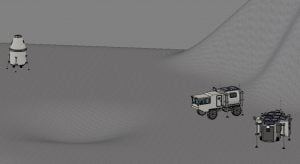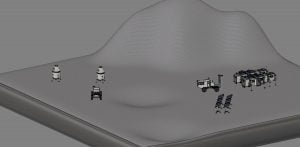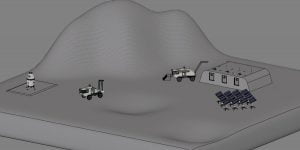Moon Camp Pioneers Gallery 2020-2021
In Moon Camp Pioneers each team’s mission is to 3D design a complete Moon Camp using Fusion 360. They also have to explain how they will use local resources, protect astronauts from the dangerous of space and describe the living and working facilities.
Team: Kingswood Oxford Aviation Club (KOAC)
Kingswood Oxford School West Hartford Connecticut United States 17
External viewer for 3d project
|
Project description
This lunar habitation project is designed to be an international, multi-mission project that enables astronauts and scientist to conduct valuable experiments on the moon and study the effects of long-term habitation on the moon. Moreover, this project will serve as a precursor of the Mars exploration and habitation project due to the uniqueness of the lunar environment. The harsh lunar environment will be able to simulate the possible condition on Mars, thus providing astronauts and scientist with a testing bed for the equipment designed for the Mars project. The lunar base consists of three core modules and several special modules with different purposes, all of the modules are interconnected and are able to be expanded for further development. The base is designed to sustain six astronauts for two months without supply. Overall, this project renders astronauts and scientists a highly valuable chance of researching the long term habitation on the moon and preparing for the Mars expedition project. |
|||
|
Where do you want to build your Moon Camp?
The camp will be constructed in the Clavius Crater located on the Southern hemisphere of the moon. Recent research from NASA has confirmed the existence of water in the Clavius Crater, thus it will be an ideal researching area since water is essential to the prolonged human habitation on the moon. Moreover, the Clavius Crater is one of the sunlight craters on the moon, thus making this location extra ideal since the solar panels in the camp could harvest energy from the sun continuously. How do you plan to build your Moon Camp? Describe the techniques and materials you would use.
The construction process of the camp consists of three phases, each phase serves a different purpose. In phase one, a lunar multi-functional mobility vehicle (LMMV) will be delivered to the chosen campsite. This vehicle is able to drive autonomously and has a modular payload system that could attach various modules. This vehicle will conduct all the preliminary work, such as finding the exact landing spot, before the astronauts arrive. The LMMV is also responsible for assembling the modules. Then, a core module and a science module will be delivered to the campsite. Lastly, three astronauts will be sent to the camp after the core module and science module are assembled. In phase two, the second core module and science module will be delivered to the camp. Another three astronauts will be sent to the camp. The moon orbit station will also begin to construct. Finally, in phase three, the last core module and science module will be delivered to the camp with a drilling module and regolith collection module for the LMMV. The astronauts will use the LMMV with the regolith collection module to cover the base with a layer of regolith for added radiation and meteoroid protection. The environment on the Moon is very dangerous for the astronauts. Explain how your Moon Camp will protect them.
Cosmic radiation and meteoroid impacts are the two major threat to the astronauts living on the moon. All of the modules are equipped with a composite layer of radiation reduction materials in the shells, and the water tanks in each module are placed between the outer shell and the inner shell, which will provide an added protection since water could slow down the protons. In addition to the composite layer or radiation reduction materials, the shells of the modules also equip with an aramid layer and a rubber layer for meteoroid protection. Inspired by ballistic vests and self-sealing fuel tanks, the aramid layer could significantly slow down the velocity of the meteoroid and the rubber layer could form an air-tight seal if the shell is penetrated. Moreover, in phase three, astronauts will cover the base with a layer of regolith, this regolith layer will provide extra protection from cosmic radiation and meteoroid impacts. Explain how your Moon Camp will provide the astronauts with:
|
|||
|
Water
|
Food
|
Electricity
|
Air
|
|
A supply mission is scheduled for each month, the supply ship will bring pure water to the camp with other essential needs. The camp also equips a water recycling system that could recycle the moisture in the air and astronauts’ urine and purify them into potable water. If the astronauts discovered ice, the ice could also be collected and be purified into potable water using the same system. The base also has an emergency supply of water that could support eight astronauts for half a month. |
The monthly supply mission supplies the base with an ample amount of pre-packaged food; this is the major food source in the base. The vegetables grew in the hydroponic/science module could also be consumed. The base also has an emergency supply of water that could support eight astronauts for half a month. |
Most of the power used in the base will be collected by various solar panels located adjacent to the modules. The base also equips with multiple radioisotope thermometric generator (RTG) for emergency use. On normal days, the RTGs serve as heat sources in the base and the power they produced will be stored in the batteries in the base. This battery could be used in emergency situations, they could also be used for aiding the sudden electricity need in the base if there are power demanding operations being performed in the base. |
The air in the base consists of a mix of oxygen and nitrogen to prevent fire. Most of the air could be recycled by the air recycling system, and the carbon dioxide will be scrubbed away during the recycling process. The monthly supply ship also brings a small amount of air to the base to compensate for the air loss. All astronauts have a emergency chemical oxygen generator in case of rapid air loss. |
|
Explain what would be the main purpose of your Moon Camp (for example: commercial, scientific, and/or tourist purposes).
The main purpose of this camp focus on scientific purposes. It will provide scientists and astronauts from worldwide with an exceptional chance for researching and discovering topics such as the moon’s geology, and the human’s long term habitation on another planet. Moreover, the harsh condition of the lunar environment provides an excellent simulation for the future Mars exploration project. |
|||
|
Describe a day on the Moon for your Moon Camp astronaut crew.
In order to maintain the safe operation of the base, astronauts work in eight-hour shifts to monitor the base, therefore, the concept of “a day” is relatively loose in the lunar base. The tasks of each astronaut will vary with the speciality of each astronaut, scientists will spend most of their time conducting experiments in the science modules, and engineers will spend most of their time inspecting and monitoring the operations in the base. Normally, astronauts are responsible for maintaining the operation of the base, inspecting for failures or leakage, contacting the mission control on Earth, conducting experiments in the science module, and conduct a mandatory workout during the eight-hour shift. Extra-Vehicular Activities (EVA) and lunar vehicle operation will be specially scheduled by the commander. |
|||






